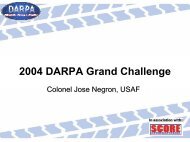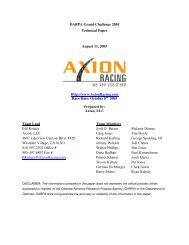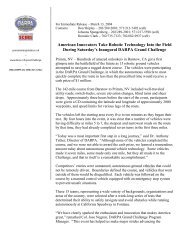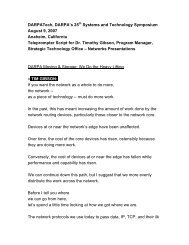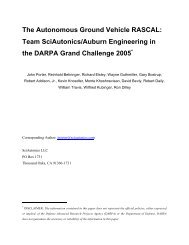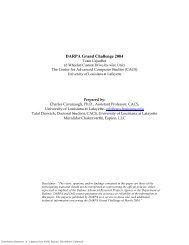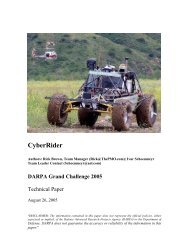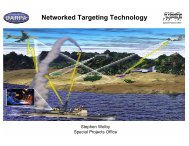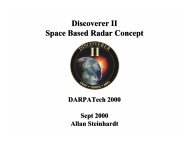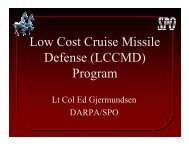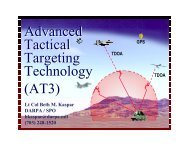Mr. Preston Carter - Defense Advanced Research Projects Agency
Mr. Preston Carter - Defense Advanced Research Projects Agency
Mr. Preston Carter - Defense Advanced Research Projects Agency
Create successful ePaper yourself
Turn your PDF publications into a flip-book with our unique Google optimized e-Paper software.
<strong>Mr</strong>. <strong>Preston</strong> <strong>Carter</strong><br />
Tactical Technology Office (TTO)<br />
RASCAL<br />
Good Afternoon. I'm here to tell you about the RASCAL Program.<br />
Pardon me for a few minutes, as I take you into the future. The year is 2009. The United States is now in the<br />
second year of a war against the Quadrature of Evil. The "Quad,” as the media calls them, has been quiet<br />
since its attempt to detonate a nuclear weapon in the streets of San Francisco just a month ago.<br />
Recently, the eyes of the nation's intelligence agencies have focused on a small patch of frozen tundra<br />
isolated by ancient steppes. It is here that sporadic information from sources indicates that the Quad is<br />
making preparations for its next attack with a little understood weapon of mass destruction.<br />
Satellite coverage of the area is running at about 8 percent, with a 1-hour gap that is causing a great deal of<br />
uncertainty. Tonight, information suddenly indicates that the Quad is only about 12 hours from its first, and<br />
only test, of its new weapon. After making a quick call to the intelligence director, the duty officer dispatches<br />
the well-rehearsed order over the wide area defense network: "Launch the ready alert RASCALs."<br />
The scene now shifts to Rumsfeld Air Force Base in the southeastern United States. From her office, the<br />
base commander, Col Cathy Dyer, hears the roar of four RASCAL launch vehicle jets taking off and thinks,<br />
"We will know more soon”. Minutes later, the 4 jets go "feet wet" over the Atlantic Ocean. After a cruise<br />
period of 30 minutes, the planes enter a racetrack holding pattern at 35,000 feet, some 250 nautical miles<br />
from their home airfield. Only one of the RASCAL vehicles is manned.<br />
The pilot onboard that manned version, Maj Albert Reynolds, reports "RASCAL 4-Mike, holding at angels 35,<br />
all systems go.” Thereafter come identical reports from the three ground-based RASCAL operators.<br />
In the lone manned RASCAL jet, Maj Reynolds thinks, "Such a shame"—not for the three ground RASCAL<br />
operators, but for me. In a month, his plane—the last of the manned RASCAL versions—will go to depot<br />
and the pilot's seat will be removed.<br />
Maj Reynolds reminisces for a brief moment, recalling that first-ever RASCAL test flight he piloted, only<br />
3 years ago. It was late 2006, putting him in the same ranks as Scott Crossfield, first pilot of the X-15.<br />
Thirty minutes have now passed since the lead RASCAL jet entered its loiter. Suddenly, all four pilots are<br />
refocused by the command center.<br />
"RASCAL 4-Mike, confirm new mission update received.”<br />
Maj Reynolds replies, "Roger that, new inclination received and orbit insertion conditions have been<br />
modified.”<br />
Seconds later the command center orders "RASCAL 1-Uniform, you are a ‘go’ for zoom.”<br />
Now we focus inside the command center. There, from the comfort of his RASCAL workstation,<br />
Capt Harrison Marsh acknowledges the order. Tonight, Capt Marsh is controlling his tenth mission this year.<br />
Not a bad pace, he thinks.<br />
Considering RASCAL now flies at least 20 times per year, Harrison believes he should be able to control<br />
another RASCAL flight or two before he detaches and transfers to his dream job in Arlington, Virginia, as a<br />
DARPA Program Manager.<br />
After receiving the "go for zoom" command, the built-In test subsystem onboard each RASCAL<br />
autonomously completes a health diagnostic of the aircraft, the expendable rocket vehicle and the satellite<br />
payload, all in less than 1 minute.
Capt March selects the "Accept Zoom" command at his workstation, and the vehicle begins to accelerate.<br />
As the plane begins its climb, the MIPIC subsystem comes to life. MIPIC stands for mass injection<br />
precompressor cooling. A fine mist of water is being injected into the air ahead of the inlet of the vehicle's<br />
turbojet engine. This system is doing two things: it is cooling the compressor of the engine, preventing it<br />
from overheating as the plane goes faster and faster; and, by cooling the air, it is making it more dense,<br />
which actually increases the thrust of the engines. This allows conventional turbojet engine to accelerate the<br />
vehicle to higher and faster flight conditions than normally possible.<br />
RASCAL 1 - Uniform continues its upward zoom, passing through Mach 2 and Mach 3. At 100,000 feet and<br />
Mach 4.0, the MIPIC subsystem continues to operate, now injecting liquid oxygen to compensate for the thin<br />
atmosphere and to maintain high thrust. As the plane exits the atmosphere, the plane's reaction control<br />
system begins to operate. At this point, the jet engines throttle back and shut down as prescribed.<br />
At 150,000 feet, the workstation provides notification that the zoom target conditions have been met and the<br />
payload remains in excellent health as the craft coasts upwards. The pilot authorizes the staging of the ERV,<br />
or expendable rocket vehicle.<br />
The RASCAL 1 – Uniform’s rocket bay doors open, exposing for the first time the rocket and satellite<br />
payload to the outside environment. They are softly ejected from the bay to continue their journey to orbit.<br />
The RASCAL ERV is the Apollo "Lunar Excursion Module" of its day. A pure space vehicle, it is not<br />
designed to fly in the atmosphere. Above 200,000 feet, there's not much of an atmosphere. At this flight<br />
condition, the ERV is experiencing a total dynamic pressure of about 1 pound per square foot. That's about<br />
the same pressure you'd experience yourself while peddling your bike in low gear, at about 5 miles per hour.<br />
So, in effect, there's little need for fancy aerodynamic surfaces on the rocket.<br />
The ERV is the subsystem that has the highest recurring cost per launch. By using low-cost rocket<br />
technology and taking advantage of its exo-atmospheric flight regime, the recurring cost of a RASCAL<br />
launch is kept low. The ERV has two stages. After each stage burns out, they eventually fall back to Earth<br />
and are not recovered. There is a small maneuvering module carrying the payload for final orbit insert and<br />
trim.<br />
While the ERV and payload accelerate to orbit, each RASCAL airplane falls back into the atmosphere. The<br />
plane maintains a high angle of attack as it returns to avoid reentry heating and as it decelerates. At Mach 4,<br />
the reentry into the atmosphere is not as dramatic as reentry from space, but the flight techniques are much<br />
the same. Once the vehicle decelerates below Mach 1, the engines are restarted and the flight back to the<br />
base is begun.<br />
One by one, the other RASCAL vehicles launch their payloads. The planes safely reenter the atmosphere,<br />
restart their engines, and head for Rumsfeld Airfield.<br />
Col Dyer, is driving to the command center as she hear the jets coming home. When back on the ground,<br />
the planes will head for the hanger where they'll be prepared within 24 hours for a new mission.<br />
Now, in orbit, four small measurement and signal intelligence microsatellites begin the collection and<br />
transmission of critical data for the intelligence directorate. At dawn the next morning, Col Dyer sees off four<br />
B-2s, each loaded with a bay full of precision targeted ordnance, on their way to give a little surprise to the<br />
Quadrature of Evil while they test their weapon on the tundra.<br />
This marks the end to my journey into the future and my attempt to be the next Tom Clancy. The people and<br />
places discussed in the last few minutes are make believe, of course—although I will submit that I am a lot<br />
like Capt Marsh and believe that being a DARPA program manager is a dream job.<br />
My name is <strong>Preston</strong> <strong>Carter</strong> and I am the Program Manager for RASCAL. In my little novel, the people and<br />
places are make believe, but the specific technological details of the operation are the objective of DARPA's<br />
RASCAL program.
RASCAL—which stands for Responsive Access, Small Cargo, Affordable Launch—is a space program<br />
started this year. The system architecture and concept of operations are exactly those painted by my<br />
journey into the future. Our goal at DARPA is to create a launch system capable of placing payloads up to<br />
130 kg in low earth orbits. By properly balancing the requirements between reusable and expendable<br />
portions of the vehicles, maintaining low operating costs, and easing payload interface requirements, we<br />
hope to achieve a launch cost of $750,000, assuming a flight rate of 20 launches per year.<br />
RASCAL will provide two unique capabilities: dedicated launch of small payloads and responsive access to<br />
space. RASCAL will demonstrate and explore many other technological frontiers, including:<br />
* Highly operational, reusable launch vehicles<br />
* Trans-atmospheric flight<br />
* High mach number and accelerator turbojet propulsion<br />
* Low-cost expendable launch vehicles<br />
* Adaptive launch operations<br />
* Vibration isolated payload interfaces<br />
Since there are significant applications in both commercial and military sectors, DARPA is using Other<br />
Transaction agreements with its industry partners.<br />
The RASCAL Program is being executed in three phases: a system study phase, a design phase, and the<br />
final build-and-flight phase.<br />
This spring, DARPA selected six performers to begin the Phase 1 system studies. This phase will be 9<br />
months long with a spiral downselect at the end to two partners who will continue to Phase 2.<br />
Phase 2 is a 12-month design phase that will carry the performers through preliminary and critical design<br />
efforts.<br />
The final spiral downselect to a single winning design will begin Phase 3, the construction, test, and<br />
demonstration of the RASCAL system.<br />
Flight tests will begin in fiscal year 2005 with final system demonstrations in fiscal year 2006.<br />
The six Phase I performers are:<br />
* Northrop Grumman<br />
* Coleman <strong>Research</strong> Corporation<br />
* Pioneer Rocketplane<br />
* Delta-Velocity<br />
* Space Access<br />
* Space Launch Corporation<br />
In addition to the six RASCAL performers, DARPA has five small companies working on MIPCC turbojet<br />
technology. Later this year, these teams will demonstrate full-scale turbojet engines in MIPCC mode<br />
operating at critical flight conditions, including Mach 3 at 100,000 feet altitude.<br />
DARPA has a long history of launch vehicle development. One of DARPA's first programs was the Saturn V<br />
launch vehicle, which was later transfer to NASA for the Apollo Program. In the late 80s we developed the<br />
Pegasus launch system, followed by the Taurus launcher in the 1990s.<br />
The RASCAL Program hopes to continue DARPA's leadership in the advancement of launch vehicle<br />
development.<br />
Thank you.



